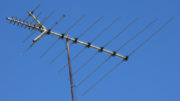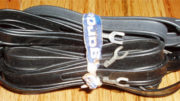The antenna your grandparents bought in 1961 still works. The antenna you buy today will still work in 2081. Is that all there is to this question? Yes and no. There are a few things you need to know before you start thinking of any TV antenna as “futureproof.”
Follow the frequencies
In the 1960s, over-the-air television was really the only sort of television there was. A few communities had primitive forms of cable television but it wasn’t mainstream. And television was important. It was so important that pretty much the entire broadcast spectrum from 54-806MHz was devoted to it. There were a few chunks here and there used for other purposes but television was the biggest user of that spectrum, by far.
Channels 2-83 were needed because new stations were popping up all the time. The broadcast equipment at the time was “sloppy.” Broadcasters couldn’t avoid contaminating adjacent channels with leftover signal. So, rules were created that no two broadcasters within a certain radius could broadcast on adjacent frequencies. The result was, in denser parts of the country, about 75% of the available frequencies couldn’t be used.
In order to get all those frequencies, you needed a big antenna. You really needed the biggest parts for the low frequencies. As those frequency numbers get higher, you need a smaller and smaller antenna.
What happened to all those channels?
Over time, channels 37-83 were given over to other purposes. This happened in waves. 70-83 were the first to go, followed by 51-69. Recently television broadcasters lost access to 38-51. (Channel 37 was taken away back in the 1960s for radio astronomy.)
What happened to all this valuable spectrum? Most of it went to cell phones. Cell phones now use frequencies in the 600, 700, and 850MHz ranges, which were once populated by television broadcasts. Cell phones weren’t thought of back in the early days of TV, and they need to use high frequencies so they can have relatively small antennas.
Not that any of that mattered.
In general, that old antenna your grandparent put up still worked. Yes, it also picked up some cell signals but in most cases that wasn’t an issue. There were (and are) filters to block out those cell signals if they became a problem.
OK smart guy, what about 4K?
There’s a rumor going around that at some point in the future, who knows when, there will be 4K over-the-air television. There are test broadcasts going on now in several cities. But it’s not clear whether or not there will ever really be 4k over the air television. Most people really aren’t worried about it right now. If it does happen, though, it’s going to be several years away. And as far as your antenna is concerned, it won’t make a bit of difference.
Every antenna is 4K ready right now
You’ve seen stickers on antennas that say they are 4K ready. Technically that’s true because every antenna is 4K ready. The antenna doesn’t know if it’s receiving a 4K signal. You didn’t need a new antenna when your TV went digital. You didn’t need a new antenna when your TV went to color or got stereo. The antenna simply doesn’t care what’s in the signal it’s receiving. It only cares about the frequency, nothing more.
So what’s the best option for a futureproof antenna?
That’s the good news. The best option for a futureproof antenna is the antenna you can get today. Get a durable antenna like something from Televes and you’ll be set for years to come. Most likely, if there is a change in the frequencies used by antenna TV it will be to make the pool smaller not larger. Tomorrow’s antennas may be smaller than today’s, especially if some of those lower-numbered channels are given away to another purpose. But your antenna will still work. Tomorrow’s antennas may be smaller, or more efficient, or more powerful. But that doesn’t mean today’s antennas will stop working.
Get a futureproof antenna from Solid Signal
When you shop for an antenna from Solid Signal, you’re getting the best selection of futureproof antennas. Don’t know which one to choose? Get a recommendation from a real antenna technician, or call us at 888-233-7563 to speak to someone from our Novi, Michigan call center. An antenna is a great investment, and Solid Signal’s the best place to get one.





